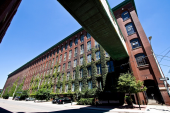
In Toronto, where the architectural landscape is in constant flux, an ever-growing army of glass condominiums raises questions about the lifespan of mass-constructed housing and the communities we create, or fail to create, around these buildings. Defensible Space, photographer Mark Bovey’s exhibit, on now at The Mascot café in Parkdale offers up a possible answer. On display until May 13, the exhibit looks at what can happen to social and corporate buildings after their purpose in a community, in society, dissipates.
“Defensible Space is a theory written by Oscar Newman in 1973 that deals with the idea of public health in relation to community design” reads the introduction to the show, a collection of nine large-scale photographs of abandoned buildings in and around Toronto.
The public exhibit is a first for Bovey, who has been taking photographs as a hobby for over 20 years, but felt that online methods of sharing his work like Facebook and Flickr weren’t doing the images justice. “When I put them online, they just had no life to me,” he says. But in a larger scale, the images have a presence of place that transports the viewer and provides an access point for thinking differently about the spaces we currently inhabit.
A deeper look into how design affects community, at how architecture can give people a sense of ownership and responsibility to the spaces they inhabit, is important as Toronto expands. Among the buildings featured in the exhibit: a hotel, a mental institution, a corporation’s headquarters, were once all thriving pinnacles of community and architecture, and yet, as society and design evolved, they became obsolete. The exhibit forces us to consider if and how we might prevent this from happening to infrastructure being constructed in Toronto now.
Closed for Maintenance, Bovey’s favourite piece in the exhibit greets viewers as they enter The Mascot. It depicts the hotel pool of a former gem of modern architecture, described to have finally met its end at the hands of the SARS outbreak in 2003. “I’ve always loved the pool and I think I’m partially a little bit attached to that location because that was a…strangely romantic location,” he says.
The names and locations of the buildings in Defensible Space are undisclosed, a common practice for urban explorers such as Bovey and his photography parterns Jamie Mageau and Rob Nourse. They espouse Broken Window theory, which holds that well-maintained buildings discourage further vandalism. The abandoned buildings in the exhibit provide an interesting cultural and visual study, but also attract more damage. In keeping the locations secret, the hope is to preserve the buildings from being destroyed. One building was once “the end all, be all, worldwide [of corporations],” Bovey tells me. But, he mentions later, “that place has basically been set on fire about a dozen or so times.” 21, another piece in the exhibit also shot in this location wins me over with its quote from Ladytron’s Seventeen, perfectly encapsulating how most buildings, just like most models, have limited life spans.
They only want you when you’re 17, when you’re 21, you’re no fun. 21. Image via Mark Bovey
All the pieces in the show are for sale and their locations will be revealed to the purchasers. As for the rest of us, Bovey explains that most abandoned buildings “eventually just get burnt down and [people] can’t burn them down if they don’t know where they are.”
A google search and some light digging will reveal the location of Closed for Maintenance to those eager to know the building’s history. In this case, its distance from downtown may have actually helped preserved it. Bovey tells me that “the further the buildings get away from urban centres, the less damage there is by humans.”
When I ask for his thoughts on how the Defensible Space theory might play out when it comes to the future of the many condo developments going up in Toronto today, he points out that it all depends on the sense of community fostered by design. “The individual that occupies the space has to feel a closer connection to, not only the space that they’re within, but the sidewalk outside.” He cites the failure of Alexandra Park because it was created as a “gated community for one type of individual,” and points out the need for mixed-use communities that allow inhabitants to “live, work and play,” as proposed by Jane Jacobs.
Communities built for one type of individual are exactly what I see when I look at City Place and Liberty Village. Bovey partially attributes this to the fact that Toronto is still growing and points out that, in the meantime, some people are taking spaces into their own hands, tailoring them into what they need. For instance, buying two smaller condos and linking them.
On the other hand, he admits that there’s a possibility that he will find himself in some of these buildings, photographing their decay in thirty years. “Phillip Stark said…good design endures…there are some properties that are well designed and they will live forever, barring social change…[whereas others are] just built as boxes for people to live in and that is where you get into that disconnect between the human emotion and the space that they occupy.”
And so the question remains: What will happen when the dozens of condo towers going up downtown no longer fit the lifestyle of their inhabitants? After all, people’s needs change and, as Bovey says, design moves on.
____
Eva Voinigescu is an intern at Toronto Standard. Follow her on Twitter @EvaVoinigescu.
For more, follow us on Twitter at @torontostandard and subscribe to our Newsletter.














